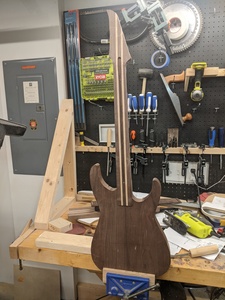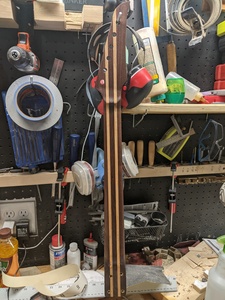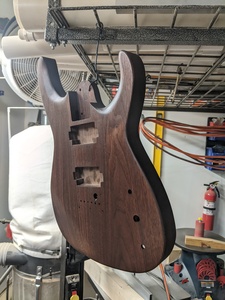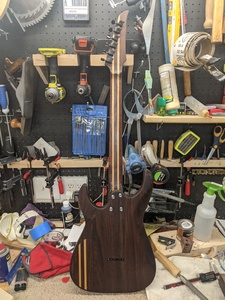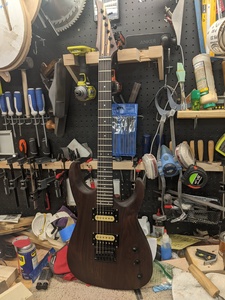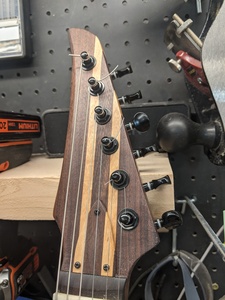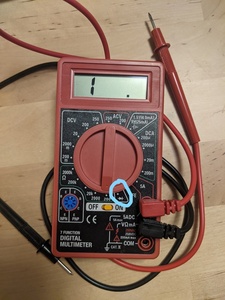Hi there!
My name is Peter and I "play" guitar from my teenage days which were some time ago. Couple years ago I discovered woodworking and I made quite a lot furniture for my house and I was looking for a challenge. For unknown reason youtube recommended me some kit builds and I knew this is it. This is my hobby. I made an investigation and decided that kit is too easy and I have all tools to do the whole thing from the scratch. I have screw driver, what else do I need 😉
I didn't have any knowledge about deep guitar anatomy and I discovered Guitar Making channel too late and I found some plans on the Internet which the shape was great and amount of details good enough I can start the build. I decided I will build this axe https://www.electricherald.com/msk-guitars-mk1hh24-templates/
I was not able to find any pictures of this guitar on the Internet and I improvised and modified things little bit. For instance I didn't noticed these black stripes on the neck is not lamination but a carbon fiber support. So I made a laminated neck instead 🙂
I got some walnut and hard maple and printed templates. I don't have much pictures from the build unfortunately because this build was meant to be an experimental build and I was sure there will be a failure at some point so the instrument won't be usable. I was surprised I can play this thing now 🙂
Day 1
And after like 30 days of investigation how do this thing
At this point of the build I was after watching some videos from the course I was sure I have done everything right. I was wrong because fretboard was glued in a wrong position. Space between last fret and the end of the neck was off and I think I twist fretboard little bit. At that point I was thinking about good wall decoration, not an instrument but I wanted to finish the build to know the process better.
10 days later I finished the build. I have so many difficulties with leveling neck and threads. In North Carolina, where i live, humidity in my garage was about 80% and I think that was the main problem with neck. I invested in dehumidifier and now I keep it at ~50% so next builds should be more precise. Will see.
I think it is a blasphemy to paint the wood. I wanted to see walnut. I wanted to have it little bit brighter but what I can do now :/ I used boiled linseed oil with mineral spirit, poly and few drops of japan drier. After 4 days and ~10 layers of thin layers of finish it doesn't look like I wanted but it is nice. Unfortunately I don't have a buffer and manually buffing didn't get me good results but I will try again in a month when finish cures. Buffer is definitely next tool I will try to get.
Almost finished guitar looks pretty neat. I love the shape and the most important - I made it. I did something impossible, reserved for real artists and druids!
I was not able to find exact nut which is specified in the spec so I did a hardcore way and wanted to do it by myself from the bone nut plank. And hmm, it is working - I think, but I don't have good nut files and I think I will replace it for something pre-made. Just to see the difference.
As a summary, I love my new hobby. I have already plans for next 2 builds, wood is acclimating in my dry garage.
From bad things I have to work on for next build:
- I have to love sanding... I missed so many places I should spent more time on
- I didn't do proper grounding. I think the wire I put under the bridge doesn't work well because each time I touch string I hear it in the amp. I used black paint + graphite powder to paint cavities but I think I also failed there. Guitar is super noisy :/ I have to crank noise suppressor a lot to cut off the noise and sound is not that great then. I am death metal guy so it boters me only when I made pauses or something like that
- I need to practice finishing. I didn't put any grain filler and buffing is next step in my to do list
- I used cheapest parts I was able to find. Next build I will not make that mistake
Please let me know if you have any questions or suggestions, I am very open for conversation 🙂
Hey that is not bad for a first go - I'm sure any of us would be proud of that. Neat coverplate!
Sometimes it can be tricky to get an electrical contact with black hardware...you could try roughing up the contact surface with a file?
I am currently getting my shielding paint from stewmac:
https://www.stewmac.com/electronics/shielding/conductive-shielding-paint.html
If you want to eliminate noise completely you could try some active EMG's?
Measure twice, cut once...
@markbailey I used DIY paint option because I saw prices for that stewmac paint. They are so darn expensive. I have HVAC aluminum tape recommended by someone from youtube but my multimeter doesn't show conductivity but I have no idea how to use this tool so I don't really know if tape would work 🙂 I will definitely remove bridge and scratch surface to get contact with chinesium.
Active EMG? Way too expensive for me.
At that point I was thinking about good wall decoration, not an instrument but I wanted to finish the build to know the process better.
Most of us have been at that point, and then worked a way through it. It's more satisfying that way!
Lots of nice design/build touches on that guitar, so if that's your build #1, they're going to be pretty impressive by the time you get to build #3, #4, #5 (and all the rest!).
Once you start building guitars, you don't stop!
Online guitar making courses – guitarmaking.co.uk
@tv101 And this is my main fear about it. Initially I invested some money for "luthier tools". Cheap stuff but for home usage I think they are fine. Even the cheapest tools, in total gave a big sum 🙂 I would need to sell some of these guitars at some point, there is no way I can afford a guitar collection. I hope I will be able to compensate materials used in these guitars, profit is out of scope at this moment - not that precision level yet.
I hope I will be able to compensate materials used in these guitars, profit is out of scope at this moment
Mark often suggests that approach ... you can probably get to a stage where you can sell the guitars for the cost of materials, plus a small profit. The profit gets spent on more or better tools enabling you to make better guitars, and a little more profit ... and so on.
But the old saying is very true ...
”if you want to make $1m by making guitars, you just need to start with $2m and a lot of spare time ...”
Its great fun though
😉
Online guitar making courses – guitarmaking.co.uk
Forgive the cynic in me, but I know so many people who like to make things, from tea cakes to dresses to guitars to arts n’ crafts and think they can build a business out of it. But the only people who make money are the ones who like making money, writing invoices, squeezing clients, profit and loss, balances...
If you like making tea cakes, make tea cakes. If you like making money, make money. But don’t expect to make teacakes and get money.
But most of all, just play guitar. 🙂
Jack of all trades and master of my own destiny. It’s only a small destiny.
@mentosik That is an absolutely amazing guitar for a first build all credit to you for carrying on even when you thought all was lost. It’s about finding ways out of dead ends, not just avoiding them in the first place!
Regards your multimeter. If it’s a multimeter you can definitely use it to check out your grounding. Slightly higher featured multimeters may have an audible ‘continuity’ setting which basically sounds a buzzer if you have a short, or zero resistance, between the two probes. This is what you want when you are checking all of your grounding ie zero resistance between various points on the guitar. If you don’t have a nice audible continuity function on your meter then set it to ‘resistance’ or ‘Ohms’ and touch the two probes together. It will likely show ‘0.000000’ or some other flashing display and this is what you want to see when you test the grounding between the various contact points on your guitar. If you get any reading that differs from what you see when you touch the probes together then you do not have a good ground between the two points and you need to investigate why.
Lacquered metal has a very good insulating layer protecting it so you will need to scrape or file away the coating to reveal the bare metal beneath in order to get a good ground contact. If you can’t see shiny metal, it is unlikely that you will get a good ground.
Hope this helps and keep the pictures coming!
Cheers
Darren
If you want more of a shine to the finish then I am not sure that mechanical buffing of the oil finish is going to achieve that. An oil finish will alway have a sheen rather than a shine but if you want a bit more gloss then I would suggest that you apply a beeswax finish on top of the oil and hand buff it. This will produce a higher degree of gloss than you can get from an oil finish alone but will still allow more of the grain of the wood to show through than with a heavy lacquer finish.
Darren
Regards your multimeter. If it’s a multimeter you can definitely use it to check out your grounding. Slightly higher featured multimeters may have an audible ‘continuity’ setting which basically sounds a buzzer if you have a short, or zero resistance, between the two probes. This is what you want when you are checking all of your grounding ie zero resistance between various points on the guitar. If you don’t have a nice audible continuity function on your meter then set it to ‘resistance’ or ‘Ohms’ and touch the two probes together. It will likely show ‘0.000000’ or some other flashing display and this is what you want to see when you test the grounding between the various contact points on your guitar. If you get any reading that differs from what you see when you touch the probes together then you do not have a good ground between the two points and you need to investigate why.
I have the cheapest stuff I was able to buy. Is this how I should have it setup? And which points should I touch?
I have
I have a 40hr/week regular job, 20 months old son and other hobbies and I cannot imagine building a business from guitars. I just know that I cannot afford building guitars over and over again and this is pretty addictive hobby. Wood for electric guitar (basic wood) is not that expensive where I live but hardware + fretboard makes a serious money. So if I can sell next build and celebrate it with a pint of beer then I would be more than happy. I know selling guitar for a $2000 you have to have a build a brand. You can buy Ibanez RG series for $400-600 brand new and the quality is pretty good for a typical bedroom player like me.
Hi Mentosik,
Leave the black probe where it is but plug (There's a bingo card shout!) the red probe into the bottom socket on the multimeter and turn the dial around to '200' on the ohms Ω scale at almost exactly 6 o'clock (this is the position, not when you should do it! 🤣).
If you then touch the ends of the two probes together the meter should display 0 or 0.00 or something equally representative of bugger all. This shows that there is no electrical resistance between the probes and this is what you want to see when checking your grounding between the various points on your guitar electrics and bridge etc.
Your multimeter is not 'autoranging' so if you are using it to check the resistance of a pot for example, you will need to rotate the dial to the appropriate setting ie max 2000Ω, max 20KΩ, max 200KΩ, max 2000KΩ.
Hope this helps
You can never have your sensible head on when thinking about what guitars cost to make or buy, it just doesn't work like that.
It is an expensive hobby for sure but there are advantages 😀
I have guitars that I would never buy in a million years but I can make for myself at a fraction of the cost. Like I always say - once you have the basics down the world is your guitar shaped oyster...
At some point a guitar playing friend will say 'can you make me one?' that can at least fund the hobby but it can be hard to let them go!
I think the buzzer setting is the one I circled here:
I think you need to move the red wire to the other hole - Touch the two ends together and it should buzz
To test the shielding just touch any 2 points in the cavity - it should buzz
Don't worry too much about shielding - it is not 'make or break' for a guitar. If noise is a problem there are other things you can do
- Turn off interence devices
- Change the room for a quiter one
- Noise gate/Expander
any other ideas folks?
Measure twice, cut once...
That's the symbol for a diode so this is for checking whether current flows through a component in a particular direction. I guess you could use it as a means of checking continuity but it's not ideal. Not all multimeters buzz, some just rely on the display read out.
Cheers
I like eating teacakes! Where do I fit in?
Depending on how many you’ve eaten @darrenking, you might not fit in anywhere anymore ...
😆
Online guitar making courses – guitarmaking.co.uk
Don't worry too much about shielding - it is not 'make or break' for a guitar. If noise is a problem there are other things you can do
- Turn off interence devices
- Change the room for a quiter one
- Noise gate/Expander
any other ideas folks?
Isn’t some forms of lighting a classic cause of buzz? Strip lights??
Online guitar making courses – guitarmaking.co.uk
I said flippantly on the livestream yesterday about a ridiculously complex guitar. Seriously has anyone ever made, or seen, a bass (or even a guitar) that was fretted for the first 12 frets and fretless thereafter. I love the high notes on a fretless bass that sound like a human voice but not so much at the bass end where I am happy with precise, fretted notes.
There may be an issue with action at the fretless end but I think this could be overcome by the 12th fret being at most the same height as the nut? I think I'll try something like this with my next project with a bit of dining room table and an old shelf.
Any advice gratefully received.
Jim
Don't worry too much about shielding - it is not 'make or break' for a guitar. If noise is a problem there are other things you can do
- Turn off interence devices
- Change the room for a quiter one
- Noise gate/Expander
My room has plenty of electronics running like few monitors, speakers, amp and apmplituner for backtracks. The other guitar is quite so I think it is "playable" environment. I will try to find better paint and repaint cavities and try again. And also make a better connection for bridge.
Any advice gratefully received.
The only advice I'd give is to make sure you keep the updates coming here! It's an interesting concept.
Some creative fret-levelling perhaps, where they fall away slightly as you go up the neck - would that help with the action on the fretless part?
What about the banjo?
Online guitar making courses – guitarmaking.co.uk



